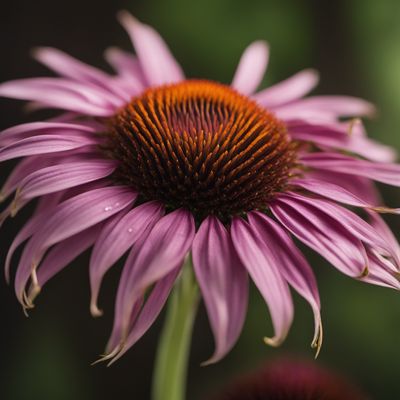
Ingredient
Pale echinacea infusion roots
The Medicinal Herb
Pale echinacea infusion roots are long, slender roots with a pale beige or light brown color. They have a woody texture and a mild earthy flavor. These roots are commonly used to make herbal infusions or teas, as they are believed to have immune-boosting properties and provide relief from cold and flu symptoms.
Origins and history
Echinacea is a genus of flowering plants native to North America. The roots of the echinacea plant have a long history of use in traditional Native American medicine. They were traditionally used to treat various ailments, including infections and wounds. Today, echinacea roots are widely cultivated and harvested for their medicinal properties.
Nutritional information
Pale echinacea infusion roots are low in calories and fat. They contain various bioactive compounds, including phenols and polysaccharides, which are believed to contribute to their immune-boosting effects. However, it is important to note that scientific evidence supporting the efficacy of echinacea roots is limited, and they should not be used as a substitute for medical treatment.
Allergens
Pale echinacea infusion roots may cause allergic reactions in individuals who are sensitive to plants in the Asteraceae family, such as ragweed or daisies. It is advisable to consult with a healthcare professional before using echinacea roots, especially if you have any underlying health conditions or are taking medications.
How to select
When purchasing pale echinacea infusion roots, look for ones that are whole, dry, and free from mold or signs of moisture. The roots should have a pale beige or light brown color. It is best to purchase from reputable sources that specialize in herbal products to ensure quality and purity.
Storage recommendations
To maintain the freshness and potency of pale echinacea infusion roots, store them in an airtight container in a cool, dry place away from direct sunlight. Proper storage helps prevent moisture absorption and degradation of the roots' active compounds.
How to produce
Pale echinacea plants can be grown from seeds or propagated through root divisions. They require well-drained soil and full sun to thrive. Harvesting the roots should be done carefully to avoid damaging the plant. It is recommended to consult with a knowledgeable herbalist or gardening expert for specific cultivation instructions.
Preparation tips
Pale echinacea infusion roots are primarily used to make herbal infusions or teas. To prepare an infusion, steep the dried roots in hot water for about 10 minutes. The resulting tea can be consumed as is or sweetened with honey or lemon. It is important to follow dosage recommendations and consult with a healthcare professional before using echinacea roots for medicinal purposes.
Substitutions
There are no direct substitutions for pale echinacea infusion roots, as their unique properties are not easily replicated. However, other herbs and botanicals, such as elderberry, ginger, or turmeric, may offer similar immune-boosting benefits and can be used as alternatives in herbal preparations.
Culinary uses
Pale echinacea infusion roots are primarily used for their medicinal properties and are less commonly used in culinary applications. They are typically consumed as herbal infusions or incorporated into herbal remedies and supplements.
Availability
Pale echinacea infusion roots are primarily cultivated in North America, particularly in the United States and Canada. They are also available in dried form from various herbal suppliers and health food stores.


